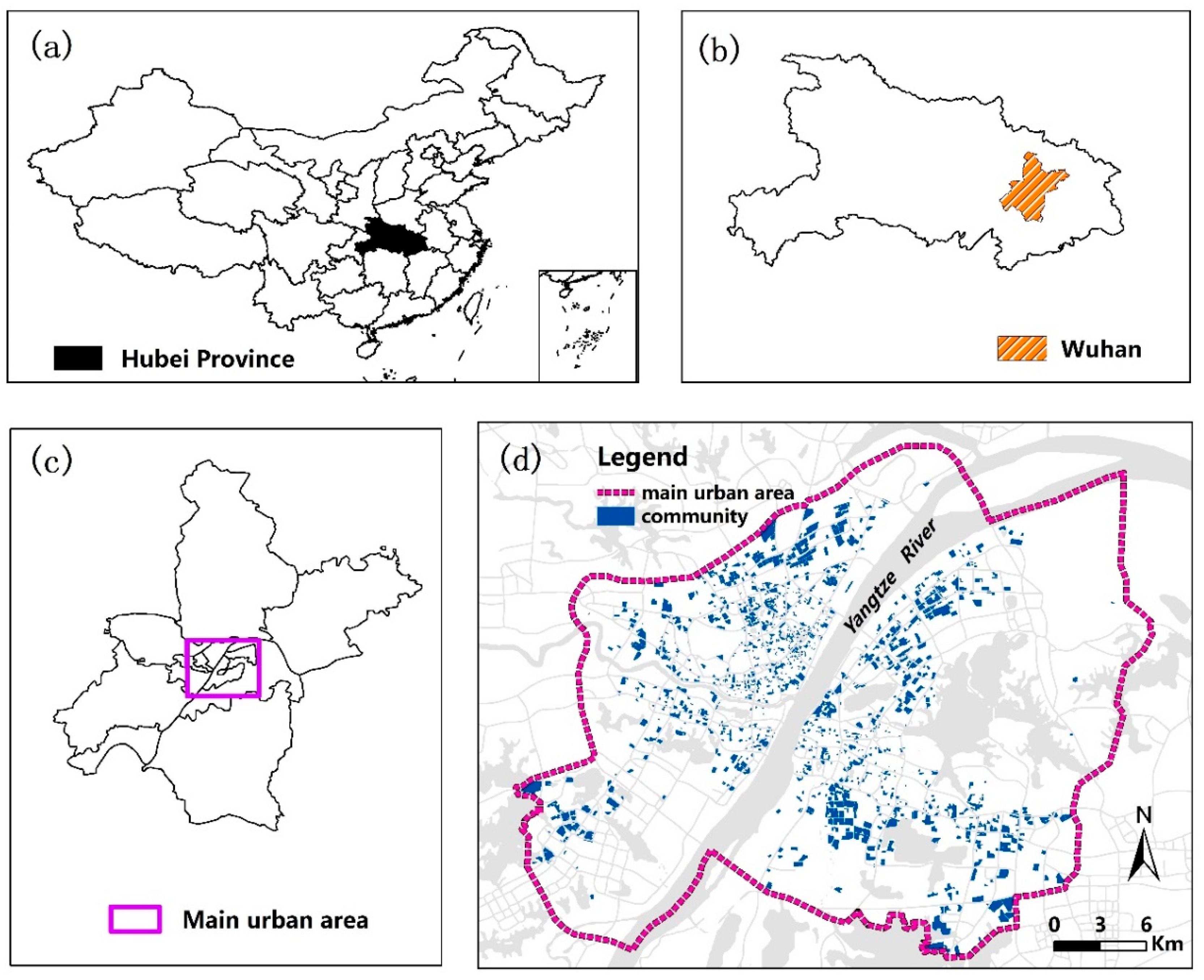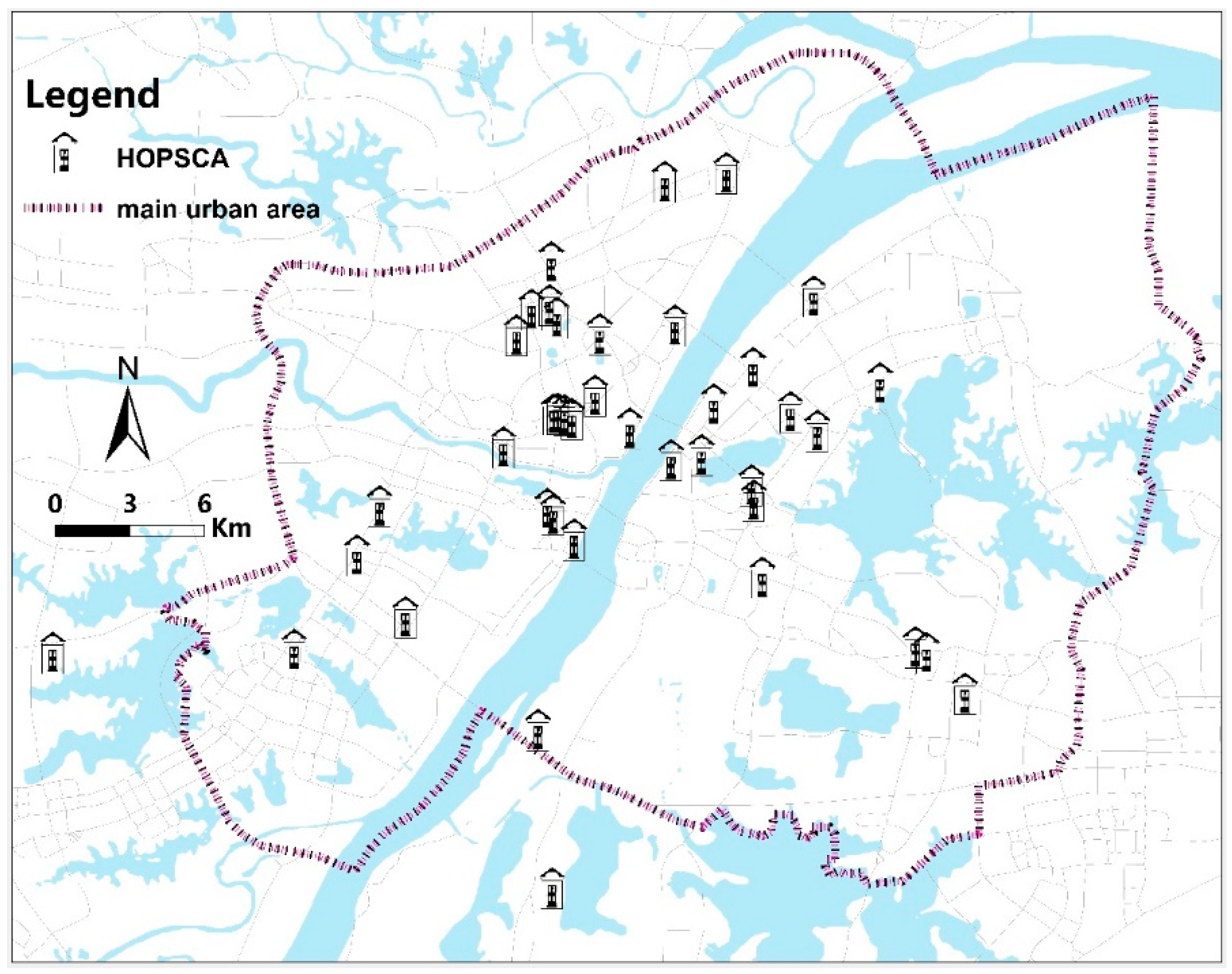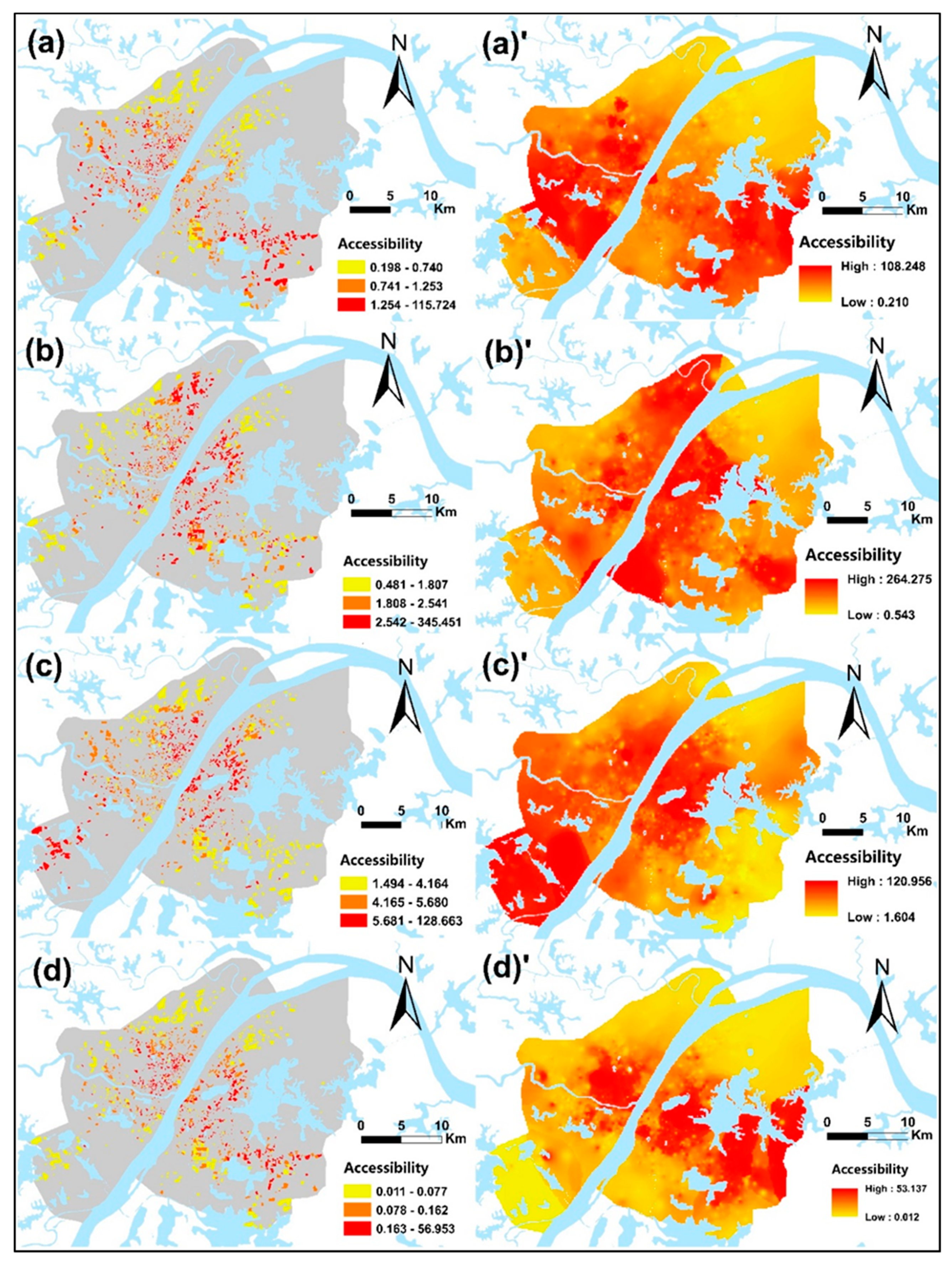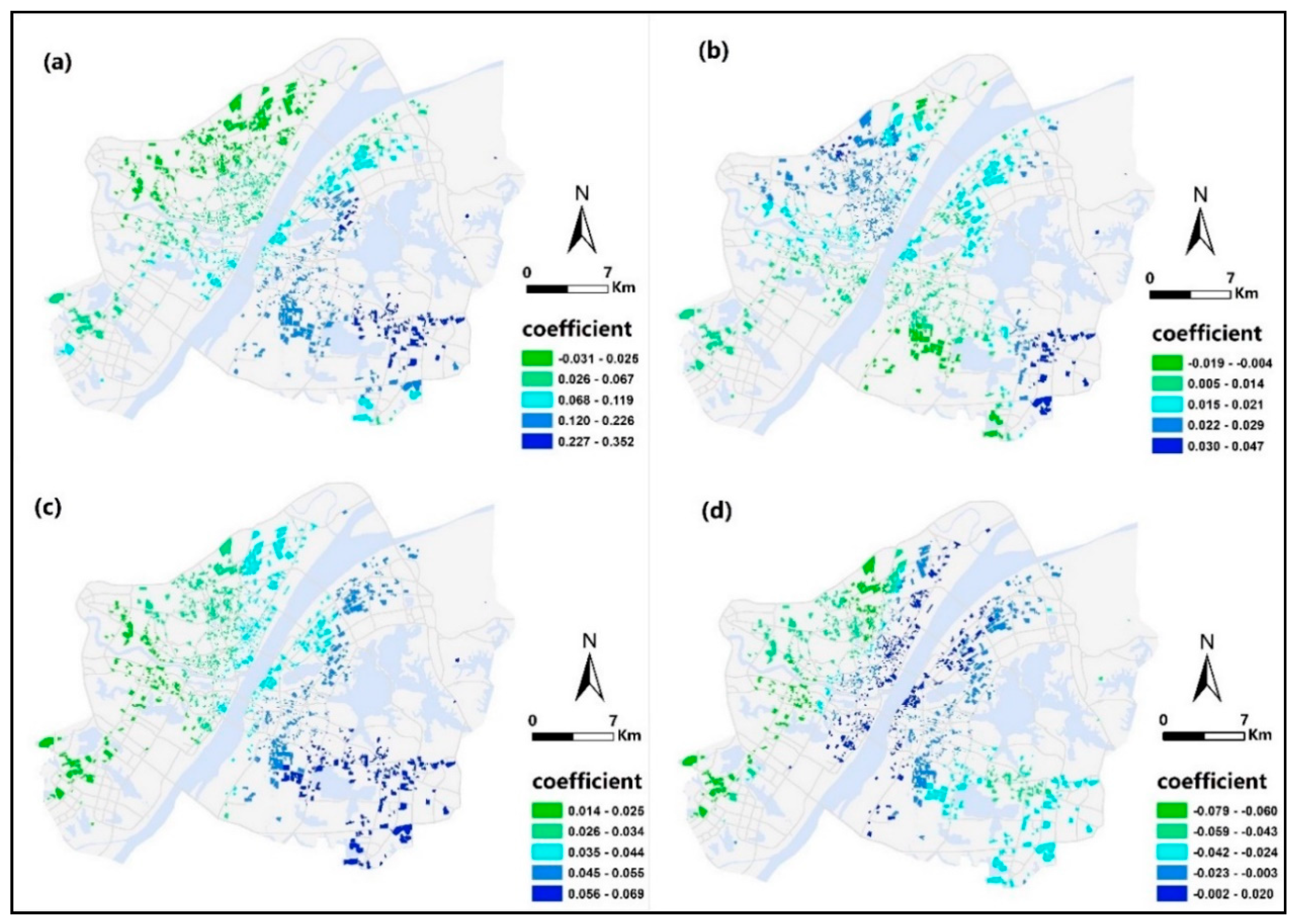The Effect of HOPSCA on Residential Property Values: Exploratory Findings from Wuhan, China
Abstract
1. Introduction
2. Literature Review
3. Materials and Methods
3.1. Methodological Considerations
3.2. Study Area and Data Sources
3.3. HOPSCA’s Classification and Accessibility Calculation
3.4. Hedonic Pricing Method
3.5. Estimation Model Specification
4. Results and Discussions
4.1. Spatial Pattern of Accessibility to HOPSCA
4.2. The Overall Effects of HOPSCA on Residential Property Values
4.3. Spatial Heterogeneity of HOPSCA Affeecting Residential Property Values
5. Conclusions
Author Contributions
Funding
Acknowledgments
Conflicts of Interest
References
- Hui, E.C.M.; Zhong, J.W.; Yu, K.H. Heterogeneity in Spatial Correlation and Influential Factors on Property Prices of Submarkets Categorized by Urban Dwelling Spaces. J. Urban Plan. Dev. 2016, 142. [Google Scholar] [CrossRef]
- Rosen, S. Hedonic Prices and Implicit Markets: Product Differentiation in Pure Competition. J. Political Econ. 1974, 82, 34–55. [Google Scholar] [CrossRef]
- Jung, E.; Choi, Y.; Yoon, H. The impact of the Gyeongui Line Park project on residential property values in Seoul, Korea. Habitat Int. 2016, 58, 108–117. [Google Scholar] [CrossRef]
- Wu, C.; Ye, X.Y.; Du, Q.Y.; Luo, P. Spatial effects of accessibility to parks on housing prices in Shenzhen, China. Habitat Int. 2017, 63, 45–54. [Google Scholar] [CrossRef]
- Wen, H.Z.; Zhang, Y.; Zhang, L. Do educational facilities affect housing price? An empirical study in Hangzhou, China. Habitat Int. 2014, 42, 155–163. [Google Scholar] [CrossRef]
- Wen, H.Z.; Xiao, Y.; Hui, E.C.M.; Zhang, L. Education quality, accessibility, and housing price: Does spatial heterogeneity exist in education capitalization? Habitat Int. 2018, 78, 68–82. [Google Scholar] [CrossRef]
- Kang, C.D. Valuing Spatial Access to Types of Retail and Effects on the Housing Price in Seoul, Korea. J. Urban Plan. Dev. 2018, 144. [Google Scholar] [CrossRef]
- Jang, M.; Kang, C.D. Retail accessibility and proximity effects on housing prices in Seoul, Korea: A retail type and housing submarket approach. Habitat Int. 2015, 49, 516–528. [Google Scholar] [CrossRef]
- Mulley, C.; Tsai, C.H.; Ma, L. Does residential property price benefit from light rail in Sydney? Res. Transp. Econ. 2018, 67, 3–10. [Google Scholar] [CrossRef]
- Geng, B.; Bao, H.J.; Liang, Y. A study of the effect of a high-speed rail station on spatial variations in housing price based on the hedonic model. Habitat Int. 2015, 49, 333–339. [Google Scholar] [CrossRef]
- Belcher, R.N.; Chisholm, R.A. Tropical Vegetation and Residential Property Value: A Hedonic Pricing Analysis in Singapore. Ecol. Econ. 2018, 149, 149–159. [Google Scholar] [CrossRef]
- Poudyal, N.C.; Hodges, D.G.; Tonn, B.; Cho, S.H. Valuing diversity and spatial pattern of open space plots in urban neighborhoods. For. Policy Econ. 2009, 11, 194–201. [Google Scholar] [CrossRef]
- Melichar, J.; Kaprova, K. Revealing preferences of Prague’s homebuyers toward greenery amenities: The empirical evidence of distance-size effect. Landsc. Urban Plan 2013, 109, 56–66. [Google Scholar] [CrossRef]
- Zhang, Z.; Tan, S.K.; Tang, W.W. A GIS-based spatial analysis of housing price and road density in proximity to urban lakes in Wuhan City, China. Chin. Geogr. Sci. 2015, 25, 775–790. [Google Scholar] [CrossRef]
- Jiao, L.M.; Liu, Y.L. Geographic Field Model based hedonic valuation of urban open spaces in Wuhan, China. Landsc. Urban Plan 2010, 98, 47–55. [Google Scholar] [CrossRef]
- Wen, H.Z.; Tao, Y.L. Polycentric urban structure and housing price in the transitional China: Evidence from Hangzhou. Habitat Int. 2015, 46, 138–146. [Google Scholar] [CrossRef]
- Waltert, F.; Schlapfer, F. Landscape amenities and local development A review of migration, regional economic and hedonic pricing studies. Ecol. Econ. 2010, 70, 141–152. [Google Scholar] [CrossRef]
- Wen, H.Z.; Xiao, Y.; Zhang, L. Spatial effect of river landscape on housing price: An empirical study on the Grand Canal in Hangzhou, China. Habitat Int. 2017, 63, 34–44. [Google Scholar] [CrossRef]
- Yu, T.; Shi, Q.; Zuo, J.; Chen, R.X. Critical factors for implementing sustainable construction practice in HOPSCA projects: A case study in China. Sustain. Cities Soc. 2018, 37, 93–103. [Google Scholar] [CrossRef]
- Zhang, X.L. Paradigm shift toward sustainable commercial project development in China. Habitat Int. 2014, 42, 186–192. [Google Scholar] [CrossRef]
- Shi, B.X.; Yang, J.Y. Scale, distribution, and pattern of mixed land use in central districts: A case study of Nanjing, China. Habitat Int. 2015, 46, 166–177. [Google Scholar] [CrossRef]
- Lau, S.S.Y.; Giridharan, R.; Ganesan, S. Policies for implementing multiple intensive land use in Hong Kong. J. Hous. Built Environ. 2003, 18, 365–378. [Google Scholar] [CrossRef]
- Wang, C.; Li, B.Y.; Li, B.Z.; Baldwin, A. Case study of “project controlling” on a large HOPSCA project in China. Eng. Constr. Archit. Manag. 2017, 24, 862–874. [Google Scholar] [CrossRef]
- Manganelli, B. Real Estate Investing: Market Analysis, Valuation Techniques, and Risk Management; Springer International Publishing: Cham, Switzerland, 2015. [Google Scholar]
- Kong, H.; Sui, D.Z.; Tong, X.; Wang, X. Paths to mixed-use development: A case study of Southern Changping in Beijing, China. Cities 2015, 44, 94–103. [Google Scholar] [CrossRef]
- Delisle, J.R.; Grissom, T.V. An empirical study of the efficacy of mixed-use development: The seattle experience. J. Real Estate Lit. 2013, 21, 25–57. [Google Scholar]
- Rowley, A. Mixed-use Development: Ambiguous concept, simplistic analysis and wishful thinking? Plan. Pract. Res. 1996, 11, 85–98. [Google Scholar] [CrossRef]
- Grant, J. Mixed use in theory and practice—Canadian experience with implementing a planning principle. J. Am. Plan. Assoc. 2002, 68, 71–84. [Google Scholar] [CrossRef]
- Hoppenbrouwer, E.; Louw, E. Mixed-use development: Theory and practice in Amsterdam’s Eastern Docklands. Eur. Plan. Stud. 2005, 13, 967–983. [Google Scholar] [CrossRef]
- Oregon Transportation and Growth Management Program. Commercial and Mixed-Use Development Code Handbook; Oregon Transportation and Growth Management Program: Salem, OR, USA, 2001; pp. 7–79. Available online: https://digital.osl.state.or.us/islandora/object/osl:9840 (accessed on 11 January 2019).
- Geoghegan, J.; Wainger, L.A.; Bockstael, N.E. Spatial landscape indices in a hedonic framework: An ecological economics analysis using GIS. Ecol. Econ. 1997, 23, 251–264. [Google Scholar] [CrossRef]
- Vorontsova, A.V.; Vorontsova, V.L.; Salimgareev, D.V. The development of Urban Areas and Spaces with the Mixed Functional Use. Procedia Eng. 2016, 150, 1996–2000. [Google Scholar] [CrossRef]
- Eizenberg, J. Here comes the neighborhood: Why urban mixed-use development works. Resid. Architect. 2003, 7, 26–28. [Google Scholar]
- Anders, M. Understanding and balancing mixed-use schemes: The key to creating successful communities. J. Retail Leisure Prop. 2004, 3, 353–364. [Google Scholar] [CrossRef][Green Version]
- Nakamura, S.; Peiser, R.; Tort, R. Are There Investment Premiums for Mixed-Use Properties? J. Real Estate Res. 2018, 40, 1–39. [Google Scholar]
- Rabianski, J.S.; Gibler, K.M.; Tidwell, O.A.; Iii, J.S.C. Mixed-use development: A call for research. J. Real Estate Lit. 2009, 17, 205–230. [Google Scholar]
- Mehri, F. Utilizing Mixed Use Theory in Order to Obtain a Sustainable Urban Development. Life Sci. J. Acta Zhengzhou Univ. Overseas Ed. 2012, 9, 1879–1885. [Google Scholar]
- Rabianski, J.S.; Gibler, K.M.; Clements Iii, J.S.; Tidwell, O.A. Mixed-Use Development and Financial Feasibility: Part I—Economic and Financial Factors. Real Estate Issues 2009, 34, 11–17. [Google Scholar]
- Rabianski, J.S.; Clements, J.S. Mixed-Use Development: A Review of Professional Literature; National Association of Office and Industrial Parks: Washington, DC, USA, 2007. [Google Scholar]
- Koster, H.R.A.; Rouwendal, J. The Impact of Mixed Land Use on Residential Property Values. J. Reg. Sci. 2012, 52, 733–761. [Google Scholar] [CrossRef]
- Moos, M.; Vinodrai, T.; Revington, N.; Seasons, M. Planning for Mixed Use. J. Am. Plan. Assoc. 2018, 84, 7–20. [Google Scholar] [CrossRef]
- Kusumastuti, D.; Nicholson, A. Mixed-use development in Christchurch, New Zealand: Do you want to live there? Urban Stud. 2018, 55, 2682–2702. [Google Scholar] [CrossRef]
- Pooler, J.A. The use of spatial separation in the measurement of transportation accessibility. Transp. Res. Part A-Policy Pract. 1995, 29, 421–427. [Google Scholar] [CrossRef]
- Black, J.; Conroy, M. Accessibility measures and the social evaluation of urban structure. Environ. Plan. A 1977, 9, 1013–1031. [Google Scholar] [CrossRef]
- Hansen, W.G. How Accessibility Shapes Land Use. J. Am. Inst. Plan. 1959, 25, 73–76. [Google Scholar] [CrossRef]
- Zhang, X.; Lu, H.; Holt, J.B. Modeling spatial accessibility to parks: A national study. Int. J. Health Geogr. 2011, 10, 31. [Google Scholar] [CrossRef] [PubMed]
- Li, Y.; He, L.; Jiao, J.; Shen, G. Quantitative Study of Housing Price Based on Huff Model and Hedonic Method. In Building Resilient Cities in China: The Nexus between Planning and Science, Proceedings of the 7th International Association for China Planning Conference, Shanghai, China, 29 June–1 July 2013; Chen, X., Pan, Q., Eds.; Springer International Publishing: Cham, Switzerland, 2015; pp. 207–221. [Google Scholar] [CrossRef]
- Salze, P.; Banos, A.; Oppert, J.-M.; Charreire, H.; Casey, R.; Simon, C.; Chaix, B.; Badariotti, D.; Weber, C. Estimating spatial accessibility to facilities on the regional scale: An extended commuting-based interaction potential model. Int. J. Health Geogr. 2011, 10, 2. [Google Scholar] [CrossRef]
- Huang, Z.Z.; Chen, R.S.; Xu, D.; Zhou, W. Spatial and hedonic analysis of housing prices in Shanghai. Habitat Int. 2017, 67, 69–78. [Google Scholar] [CrossRef]
- Helbich, M.; Brunauer, W.; Vaz, E.; Nijkamp, P. Spatial Heterogeneity in Hedonic House Price Models: The Case of Austria. Urban Stud. 2014, 51, 390–411. [Google Scholar] [CrossRef]
- Bajat, B.; Kilibarda, M.; Pejović, M.; Petrović, M.S. Spatial Hedonic Modeling of Housing Prices Using Auxiliary Maps. In Spatial Analysis and Location Modeling in Urban and Regional Systems; Thill, J.-C., Ed.; Springer: Berlin/Heidelberg, Germany, 2018. [Google Scholar]
- Brunsdon, C.; Fotheringham, S.; Charlton, M. Geographically Weighted Regression-Modelling Spatial Non-Stationarity. J. R. Stat. Soc. Ser. D Stat. 1998, 47, 431–443. [Google Scholar] [CrossRef]
- Bitter, C.; Mulligan, G.F.; Dall’erba, S. Incorporating spatial variation in housing attribute prices: A comparison of geographically weighted regression and the spatial expansion method. J. Geogr. Syst. 2007, 9, 7–27. [Google Scholar] [CrossRef]
- Dziauddin, M.F.; Powe, N.; Alvanides, S. Estimating the Effects of Light Rail Transit (LRT) System on Residential Property Values Using Geographically Weighted Regression (GWR). Appl. Spat. Anal. Police 2015, 8, 1–25. [Google Scholar] [CrossRef]
- Liang, X.; Liu, Y.; Qiu, T.; Jing, Y.; Fang, F. The effects of locational factors on the housing prices of residential communities: The case of Ningbo, China. Habitat Int. 2018, 81, 1–11. [Google Scholar] [CrossRef]
- Cao, T.V.; Cory, D.C. Mixed land uses, land-use externalities, and residential property values: A reevaluation. Ann. Reg. Sci. 1982, 16, 1–24. [Google Scholar]
- Hochmair, H.H.; Juhász, L.; Cvetojevic, S. Data Quality of Points of Interest in Selected Mapping and Social Media Platforms; Springer: Cham, Switzerland, 2017; pp. 293–313. [Google Scholar]
- Karduni, A.; Kermanshah, A.; Derrible, S. A protocol to convert spatial polyline data to network formats and applications to world urban road networks. Sci. Data 2016, 3, 160046. [Google Scholar] [CrossRef] [PubMed]
- Xiao, Y.; Wang, Z.; Li, Z.G.; Tang, Z.L. An assessment of urban park access in Shanghai—Implications for the social equity in urban China. Landsc. Urban Plan 2017, 157, 383–393. [Google Scholar] [CrossRef]
- Arbia, G.; Petrarca, F. Effects of scale in spatial interaction models. J. Geogr. Syst. 2013, 15, 249–264. [Google Scholar] [CrossRef]
- Ferlan, N.; Bastic, M.; Psunder, I. Influential Factors on the Market Value of Residential Properties. Inzinerine Ekonomika-Eng. Econ. 2017, 28, 135–144. [Google Scholar] [CrossRef]
- Li, R.; Cheng, K.; Shoaib, M. Walled Buildings, Sustainability, and Housing Prices: An Artificial Neural Network Approach. Sustainability 2018, 10, 1298. [Google Scholar] [CrossRef]
- Taylor, L.O. Theoretical Foundations and Empirical Developments in Hedonic Modeling; Springer: New York, NY, USA, 2008; pp. 15–37. [Google Scholar]
- Bowen, W.M.; Mikelbank, B.A.; Prestegaard, D.M. Theoretical and empirical considerations regarding space in hedonic housing price model applications. Growth Chang. 2001, 32, 466–490. [Google Scholar] [CrossRef]
- Manganelli, B.; Pontrandolfi, P.; Azzato, A.; Murgante, B. Using geographically weighted regression for housing market segmentation. Int. J. Bus. Intell. Data Min. 2014, 9, 161–177. [Google Scholar] [CrossRef]
- Lu, B.; Yang, W.; Ge, Y.; Harris, P. Improvements to the calibration of a geographically weighted regression with parameter-specific distance metrics and bandwidths. Comput. Environ. Urban Syst. 2018, 71, 41–57. [Google Scholar] [CrossRef]
- Wheeler, D.C. Geographically Weighted Regression. In Handbook of Regional Science; Fischer, M.M., Nijkamp, P., Eds.; Springer: Berlin/Heidelberg, Germany, 2014. [Google Scholar]
- Foord, J.O. Mixed-Use Trade-Offs: How to Live and Work in a ‘Compact City’ Neighbourhood. Built Environ. 2010, 36, 47–62. [Google Scholar] [CrossRef]
- Liu, Y.; Liu, X.; Gao, S.; Gong, L.; Kang, C.G.; Zhi, Y.; Chi, G.H.; Shi, L. Social Sensing: A New Approach to Understanding Our Socioeconomic Environments. Ann. Assoc. Am. Geogr. 2015, 105, 512–530. [Google Scholar] [CrossRef]




| Data Set | Type | Describe | Source |
|---|---|---|---|
| Community data | Numerical value | Transaction prices and attribute data of sample communities | Captured from the Fang.com |
| HOPSCA data | Point | Property composition, project scale, and other HOPSCA attribute information | Obtained from CricBigdata |
| POI data | Point | Various facilities of Wuhan City | Obtained from Metrodatateam |
| Road data | Polyline | Types and lengths of Wuhan urban roads | available at: http://www.nature.com/articles/sdata201646 |
| Types | Total | Proportion (%) | Function Design |
|---|---|---|---|
| Commerce-oriented HOPSCA | 16 | 38 | The main function is commerce, whose proportion is at least 50%; auxiliary functions include office building, hotels, and so on. |
| Housing-oriented HOPSCA | 15 | 36 | The main function is housing, whose proportion is at least 50%; auxiliary functions include office building, commerce, and so on. |
| Balanced-development HOPSCA | 7 | 17 | Functions of commerce, office, hotel, and housing are equally designed; the proportion of each function is less than or equal to 50%. |
| Business-oriented HOPSCA | 4 | 10 | The main function is business, whose proportion is at least 50%; auxiliary functions include commerce, hotels, housing, and so on. |
| Total | 42 | 100 |
| Characteristic | Variable | Description | Expected Sign |
|---|---|---|---|
| Structure characteristic | AGE | The years between construction year to 2017 (year) | - |
| RPOLT | Ratio of the community | - | |
| RGREEN | Ratio of the green space area of the community | + | |
| FEE | Property management fees (Yuan/Mon·m2) | + | |
| Location characteristic | NTRANSPORT | Quantity of transport facilities within a 1000 m radius of the community | + |
| NE&M | Quantity of education and medical facilities within a 1000 m radius of the community | + | |
| NLEISURE | Quantity of leisure facilities within a 1000 m radius of the community | + | |
| NCOMMERCE | Quantity of commerce facilities within a 1000 m radius of the community | + | |
| NLIVING | Quantity of living facilities within a 1000 m radius of the community | + | |
| Neighborhood characteristic | METRO | Whether the community covers any metro station within 1000 m (yes = 1, no = 0) | + |
| EDUCATION | Whether the community belongs to the designated school districts (yes = 1, no = 0) | + | |
| LANDSCAPE | Whether the community catches any famous lakes, rivers, park landscapes (yes = 1, no = 0) | + | |
| BUSINESS | Whether the community within the prosperous business circle (yes = 1, no = 0) | + | |
| Accessibility characteristic | ACOMMERCE | Accessibility to commerce-oriented HOPSCA | + |
| AHOUSING | Accessibility to housing-oriented HOPSCA | + | |
| ABALANCE | Accessibility to balanced-development HOPSCA | + | |
| ABUSINESS | Accessibility to business-oriented HOPSCA | + |
| Type | Minimum | Maximum | Mean | Standard Deviation |
|---|---|---|---|---|
| Commerce-oriented HOPSCA | 0.198 | 115.724 | 1.674 | 4.516 |
| Housing-oriented HOPSCA | 0.481 | 345.415 | 3.290 | 11.413 |
| Balanced-development HOPSCA | 1.494 | 128.663 | 6.381 | 7.159 |
| Business-oriented HOPSCA | 0.011 | 56.953 | 0.435 | 2.567 |
| Variable | Coefficient | Standard Deviation | p-Value |
|---|---|---|---|
| AGE | −0.153 *** | 0.038 | 0.000 |
| RPLOT | 0.028 *** | 0.029 | 0.000 |
| RGREEN | 0.078 *** | 0.030 | 0.000 |
| FEE | 0.261 *** | 0.037 | 0.000 |
| NTRANSPORT | 0.419 *** | 0.066 | 0.000 |
| NE&M | 0.183 *** | 0.061 | 0.000 |
| NLEISURE | −0.119 *** | 0.052 | 0.000 |
| NCOMMERCE | −0.284 *** | 0.066 | 0.000 |
| BUSINESSCIRCLE | −0.024 *** | 0.029 | 0.000 |
| LANDSCAPE | 0.218 *** | 0.030 | 0.000 |
| METRO | 0.009 *** | 0.036 | 0.000 |
| EDUCATION | 0.075 *** | 0.028 | 0.000 |
| ACOMMERCE | 0.036 *** | 0.025 | 0.000 |
| AHOUSING | 0.018 *** | 0.025 | 0.000 |
| ABALANCE | 0.108 *** | 0.028 | 0.000 |
| ABUSINESS | −0.024 *** | 0.031 | 0.000 |
| AICc | 3544.158 | ||
| R2 Adjusted | 0.460 | ||
© 2019 by the authors. Licensee MDPI, Basel, Switzerland. This article is an open access article distributed under the terms and conditions of the Creative Commons Attribution (CC BY) license (http://creativecommons.org/licenses/by/4.0/).
Share and Cite
Qin, Z.; Yu, Y.; Liu, D. The Effect of HOPSCA on Residential Property Values: Exploratory Findings from Wuhan, China. Sustainability 2019, 11, 471. https://doi.org/10.3390/su11020471
Qin Z, Yu Y, Liu D. The Effect of HOPSCA on Residential Property Values: Exploratory Findings from Wuhan, China. Sustainability. 2019; 11(2):471. https://doi.org/10.3390/su11020471
Chicago/Turabian StyleQin, Zhijiao, Yan Yu, and Dianfeng Liu. 2019. "The Effect of HOPSCA on Residential Property Values: Exploratory Findings from Wuhan, China" Sustainability 11, no. 2: 471. https://doi.org/10.3390/su11020471
APA StyleQin, Z., Yu, Y., & Liu, D. (2019). The Effect of HOPSCA on Residential Property Values: Exploratory Findings from Wuhan, China. Sustainability, 11(2), 471. https://doi.org/10.3390/su11020471






